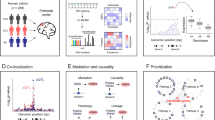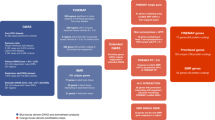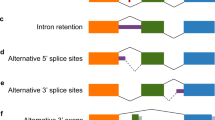Abstract
The study of schizophrenia genetics has confirmed the importance of genes in etiology, but has not so far identified the relationship between observed genetic risks and specific DNA variants, protein alterations or biological processes. In spite of many limitations, numerous regions of the human genome give consistent, although by no means unanimous, support for linkage, which is unlikely to occur by chance. Two recent shifts have been evident in the field. First, a series of studies combining linkage and association analyses in the same family sets have identified promising candidate genes (DTNBP1, NRG1, G72/G30, TRAR4). Although a consensus definition of replication for genetic association in a complex trait remains difficult to achieve, the evidence for two of these (dystrobrevin binding protein 1 (DTNBP1), NRG1) is strong. Second, a series of studies combining association with functional investigation of changes in the associated gene in schizophrenia have also identified several candidate genes (COMT, RGS4, PPP3CC, ZDHHC8, AKT1). Somewhat surprisingly, the loci implicated by these studies have proven less robust in replication, although the number of replication studies remains small in several cases. Assessment of the combined evidence for the DTNBP1 gene gives some insight into the nature of the problems remaining to be solved.
Similar content being viewed by others
Log in or create a free account to read this content
Gain free access to this article, as well as selected content from this journal and more on nature.com
or
References
Gottesman II : Schizophrenia Genesis. New York: W H Freeman, 1991.
Kendler KS, Diehl SR : The genetics of schizophrenia: a current, genetic-epidemiologic perspective. Schizophr Bull 1993; 19: 261–285.
Cardno AG, Gottesman II : Twin studies of schizophrenia: from bow-and-arrow concordances to Star Wars Mx and functional genomics. Am J Med Genet 2000; 97: 12–17.
Tienari P, Wynne LC, Sorri A et al: Genotype–environment interaction in schizophrenia-spectrum disorder. Long-term follow-up study of Finnish adoptees. Br J Psychiatry 2004; 184: 216–222.
Prescott CA, Gottesman II : Genetically mediated vulnerability to schizophrenia. Psychiatr Clin N Am 1993; 16: 245–267.
Tienari P : Interaction between genetic vulnerability and family environment: the Finnish adoptive family study of schizophrenia. Acta Psychiatr Scand 1991; 84: 460–465.
Kety SS, Wender PH, Jacobsen B et al: Mental illness in the biological and adoptive relatives of schizophrenic adoptees: replication of the Copenhagen study in the rest of Denmark. Arch Gen Psychiatry 1994; 51: 442–455.
McGue M, Gottesman I, Rao DC : Resolving genetic models for the transmission of schizophrenia. Genet Epidemiol 1985; 2: 99–110.
Kendler KS, McGuire M, Gruenberg AM, Spellman M, O'Hare A, Walsh D : The Roscommon family study: II. The risk of nonschizophrenic nonaffective psychoses in relatives. Arch Gen Psychiatry 1993; 50: 645–652.
Riley B, Kendler KS : Genetics of schizophrenia: linkage and association studies; in Kendler KS, Eaves LJ (eds): Psychiatric Genetics. Washington DC: American Psychiatric Publishing Incorporated, 2005, pp 95–140.
Pulver AE, Karayiorgou M, Wolyniec PS et al: Sequential strategy to identify a susceptibility gene for schizophrenia: Report of potential linkage on chromosome 22q12–q13.1: Part 1. Am J Med Genet 1994; 54: 36–43.
Gill M, Vallada H, Collier D et al: A combined analysis of D22S278 marker alleles in affected sib-pairs: support for a susceptibility locus for schizophrenia at chromosome 22q12. Am J Med Genet Neuropsychiatr Genet 1996; 67: 40–45.
Murphy KC, Jones LA, Owen MJ : High rates of schizophrenia in adults with velo-cardio-facial syndrome. Arch Gen Psychiatry 1999; 56: 940–945.
Egan MF, Goldberg TE, Kolachana BS et al: Effect of COMT Val108/158 Met genotype on frontal lobe function and risk for schizophrenia. Proc Natl Acad Sci USA 2001; 98: 6917–6922.
Shifman S, Bronstein M, Sternfeld M et al: A highly significant association between a COMT haplotype and schizophrenia. Am J Hum Genet 2002; 71: 1296–1302.
Glatt SJ, Faraone SV, Tsuang MT : Association between a functional catechol O-methyltransferase gene polymorphism and schizophrenia: meta-analysis of case–control and family-based studies. Am J Psychiatry 2003; 160: 469–476.
Fan JB, Zhang CS, Gu NF et al: Catechol-O-methyltransferase gene Val/Met functional polymorphism and risk of schizophrenia: a large-scale association study plus meta-analysis. Biol Psychiatry 2005; 57: 139–144.
Williams HJ, Glaser B, Williams NM et al: No association between schizophrenia and polymorphisms in COMT in two large samples. Am J Psychiatry 2005; 162: 1736–1738.
Liu H, Heath SC, Sobin C et al: Genetic variation at the 22q11 PRODH2/DGCR6 locus presents an unusual pattern and increases susceptibility to schizophrenia. Proc Natl Acad Sci USA 2002; 99: 3717–3722.
Fan JB, Ma J, Zhang CS et al: A family-based association study of T1945C polymorphism in the proline dehydrogenase gene and schizophrenia in the Chinese population. Neurosci Lett 2003; 338: 252–254.
Mukai J, Liu H, Burt RA et al: Evidence that the gene encoding ZDHHC8 contributes to the risk of schizophrenia. Nat Genet 2004; 36: 725–731.
Chen WY, Shi YY, Zheng YL et al: Case–control study and transmission disequilibrium test provide consistent evidence for association between schizophrenia and genetic variation in the 22q11 gene ZDHHC8. Hum Mol Genet 2004; 13: 2991–2995.
Pulver AE, Lasseter VK, Kasch L et al: Schizophrenia: a genome scan targets chromosomes 3p and 8p as potential sites of susceptibility genes. Am J Med Genet Neuropsychiatr Genet 1995; 60: 252–260.
Levinson DF, Wildenauer DB, Schwab SG et al: Additional support for schizophrenia linkage on chromosomes 6 and 8: a multicenter study. Am J Med Genet Neuropsychiatr Genet 1996; 67: 580–594.
Stefansson H, Sigurdsson E, Steinthorsdottir V et al: Neuregulin 1 and susceptibility to schizophrenia. Am J Hum Genet 2002; 71: 877–892.
Stefansson H, Sarginson J, Kong A et al: Association of neuregulin 1 with schizophrenia confirmed in a Scottish population. Am J Hum Genet 2003; 72: 83–87.
Corvin AP, Morris DW, McGhee K et al: Confirmation and refinement of an ‘at-risk’ haplotype for schizophrenia suggests the EST cluster, Hs.97362, as a potential susceptibility gene at the Neuregulin-1 locus. Mol Psychiatry 2004; 9: 208–213.
Williams NM, Preece A, Spurlock G et al: Support for genetic variation in neuregulin 1 and susceptibility to schizophrenia. Mol Psychiatry 2003; 8: 485–487.
Thiselton DL, Webb BT, Neale BM et al: No evidence for linkage or association of neuregulin-1 (NRG1) with disease in the Irish study of high-density schizophrenia families (ISHDSF). Mol Psychiatry 2004; 9: 777–783.
Gerber DJ, Hall D, Miyakawa T et al: Evidence for association of schizophrenia with genetic variation in the 8p21.3 gene, PPP3CC, encoding the calcineurin gamma subunit. Proc Natl Acad Sci USA 2003; 100: 8993–8998.
Miyakawa T, Leiter LM, Gerber DJ et al: Conditional calcineurin knockout mice exhibit multiple abnormal behaviors related to schizophrenia. Proc Natl Acad Sci USA 2003; 100: 8987–8992.
Kinoshita Y, Suzuki T, Ikeda M et al: No association with the calcineurin A gamma subunit gene (PPP3CC) haplotype to Japanese schizophrenia. J Neural Trans 2005; 112: 1255–1262.
Straub RE, MacLean CJ, O'Neill FA et al: A potential vulnerability locus for schizophrenia on chromosome 6p24–22: evidence for genetic heterogeneity. Nat Genet 1995; 11: 287–293.
Straub RE, Jiang Y, MacLean CJ et al: Genetic variation in the 6p22.3 gene DTNBP1, the human ortholog of mouse dysbindin, is associated with schizophrenia. Am J Hum Genet 2002; 71: 337–348.
van den Oord E, Sullivan PF, Chen X, Kendler KS, Riley B : Identification of a high risk haplotype for the dystrobrevin binding protein 1 (DTNBP1) gene in the Irish study of high density schizophrenia families. Mol Psychiatry 2003; 8: 499–510.
Schwab SG, Knapp M, Mondabon S et al: Support for association of schizophrenia with genetic variation in the 6p22.3 gene, dysbindin, in sib-pair families with linkage and in an additional sample of triad families. Am J Hum Genet 2003; 72: 185–190.
Tang JX, Zhou J, Fan JB et al: Family-based association study of DTNBP1 in 6p22.3 and schizophrenia. Mol Psychiatry 2003; 8: 717–718.
Van Den Bogaert A, Schumacher J, Schulze TG et al: The DTNBP1 (dysbindin) gene contributes to schizophrenia, depending on family history of the disease. Am J Hum Genet 2003; 73: 1438–1443.
Funke B, Finn CT, Plocik AM et al: Association of the DTNBP1 locus with schizophrenia in a U.S. population. Am J Hum Genet 2004; 75: 891–898.
Kirov G, Ivanov D, Williams NM et al: Strong evidence for association between the dystrobrevin binding protein 1 gene (DTNBP1) and schizophrenia in 488 parent–offspring trios from Bulgaria. Biol Psychiatry 2004; 55: 971–975.
Numakawa T, Yagasaki Y, Ishimoto T et al: Evidence of novel neuronal functions of dysbindin, a susceptibility gene for schizophrenia. Hum Mol Genet 2004; 13: 2699–2708.
Williams NM, Preece A, Morris DW et al: Identification in 2 independent samples of a novel schizophrenia risk haplotype of the dystrobrevin binding protein gene (DTNBP1). Arch Gen Psychiatry 2004; 61: 336–344.
Li T, Zhang F, Liu X et al: Identifying potential risk haplotypes for schizophrenia at the DTNBP1 locus in Han Chinese and Scottish populations. Mol Psychiatry 2005; 10: 1037–1044.
Weickert CS, Straub RE, McClintock BW et al: Human dysbindin (DTNBP1) gene expression in normal brain and in schizophrenic prefrontal cortex and midbrain. Arch Gen Psychiatry 2004; 61: 544–555.
Talbot K, Eidem WL, Tinsley CL et al: Dysbindin-1 is reduced in intrinsic, glutamatergic terminals of the hippocampal formation in schizophrenia. J Clin Invest 2004; 113: 1353–1363.
Emamian ES, Hall D, Birnbaum MJ, Karayiorgou M, Gogos JA : Convergent evidence for impaired AKT1-GSK3beta signaling in schizophrenia. Nat Genet 2004; 36: 131–137.
Ikeda M, Iwata N, Suzuki T et al: Association of AKT1 with schizophrenia confirmed in a Japanese population. Biol Psychiatry 2004; 56: 698–700.
Ohtsuki T, Inada T, Arinami T : Failure to confirm association between AKT1 haplotype and schizophrenia in a Japanese case–control population. Mol Psychiatry 2004; 9: 981–983.
Schwab SG, Hoefgen B, Hanses C et al: Further evidence for association of variants in the AKT1 gene with schizophrenia in a sample of European sib-pair families. Biol Psychiatry 2005; 58: 446–450.
Lin MW, Curtis D, Williams N et al: Suggestive evidence for linkage of schizophrenia to markers on chromosome 13q14.1–q32. Psychiatr Genet 1995; 5: 117–126.
Chumakov I, Blumenfeld M, Guerassimenko O et al: Genetic and physiological data implicating the new human gene G72 and the gene for D-amino acid oxidase in schizophrenia. Proc Natl Acad Sci USA 2002; 99: 13675–13680.
Korostishevsky M, Kaganovich M, Cholostoy A et al: Is the G72/G30 locus associated with schizophrenia? Single nucleotide polymorphisms, haplotypes, and gene expression analysis. Biol Psychiatry 2004; 56: 169–176.
Zou F, Li C, Duan S et al: A family-based study of the association between the G72/G30 genes and schizophrenia in the Chinese population. Schizophr Res 2005; 73: 257–261.
Korostishevsky M, Kremer I, Kaganovich M et al: Transmission disequilibrium and haplotype analyses of the G72/G30 locus: suggestive linkage to schizophrenia in Palestinian Arabs living in the North of Israel. Am J Med Genet B Neuropsychiatr Genet 2005, [E-pub ahead of print].
Wang X, He G, Gu N et al: Association of G72/G30 with schizophrenia in the Chinese population. Biochem Biophys Res Commun 2004; 319: 1281–1286.
Addington AM, Gornick M, Sporn AL et al: Polymorphisms in the 13q33.2 gene G72/G30 are associated with childhood-onset schizophrenia and psychosis not otherwise specified. Biol Psychiatry 2004; 55: 976–980.
Schumacher J, Jamra RA, Freudenberg J et al: Examination of G72 and D-amino-acid oxidase as genetic risk factors for schizophrenia and bipolar affective disorder. Mol Psychiatry 2004; 9: 203–207.
Mulle JG, Chowdari KV, Nimgaonkar V, Chakravarti A : No evidence for association to the G72/G30 locus in an independent sample of schizophrenia families. Mol Psychiatry 2005; 10: 431–433.
Cao Q, Martinez M, Zhang J et al: Suggestive evidence for a schizophrenia susceptibility locus on chromosome 6q and a confirmation in an independent series of pedigrees. Genomics 1997; 43: 1–8.
Levinson DF, Holmans P, Straub RE et al: Multicenter linkage study of schizophrenia candidate regions on chromosomes 5q, 6q, 10p, and 13q: schizophrenia linkage collaborative group III. Am J Hum Genet 2000; 67: 652–663.
Duan J, Martinez M, Sanders AR et al: Polymorphisms in the trace amine receptor 4 (TRAR4) gene on chromosome 6q23.2 are associated with susceptibility to schizophrenia. Am J Hum Genet 2004; 75: 624–638.
Duan S, Du J, Xu Y et al: Failure to find association between TRAR4 and schizophrenia in the Chinese Han population. J Neural Transm 2005, [E-pub ahead of print].
Ikeda M, Iwata N, Suzuki T et al: No association of haplotype-tagging SNPs in TRAR4 with schizophrenia in Japanese patients. Schizophr Res 2005; 78: 127–130.
Shaw SH, Kelly M, Smith AB et al: A genome-wide search for schizophrenia susceptibility genes. Am J Med Genet Neuropsychiatr Genet 1998; 81: 364–376.
Brzustowicz LM, Hodgkinson KA, Chow EWC, Honer WG, Bassett AS : Location of a major susceptibility locus for familial schizophrenia on chromosome 1q21–q22. Science 2000; 288: 678–682.
Levinson DF, Holmans PA, Laurent C et al: No major schizophrenia locus detected on chromosome 1q in a large multicenter sample. Science 2002; 296: 739–741.
Millar JK, Wilson-Annan JC, Anderson S et al: Disruption of two novel genes by a translocation co-segregating with schizophrenia. Hum Mol Genet 2000; 9: 1415–1423.
Hennah W, Varilo T, Kestila M et al: Haplotype transmission analysis provides evidence of association for DISC1 to schizophrenia and suggests sex-dependent effects. Hum Mol Genet 2003; 12: 3151–3159.
Hodgkinson CA, Goldman D, Jaeger J et al: Disrupted in schizophrenia 1 (DISC1): association with schizophrenia, schizoaffective disorder, and bipolar disorder. Am J Hum Genet 2004; 75: 862–872.
Thomson PA, Wray NR, Millar JK et al: Association between the TRAX/DISC locus and both bipolar disorder and schizophrenia in the Scottish population. Mol Psychiatry 2005; 10: 657–668, 616.
Callicott JH, Straub RE, Pezawas L et al: Variation in DISC1 affects hippocampal structure and function and increases risk for schizophrenia. Proc Natl Acad Sci USA 2005; 102: 8627–8632.
Devon RS, Anderson S, Teague PW et al: Identification of polymorphisms within Disrupted in Schizophrenia 1 and Disrupted in Schizophrenia 2, and an investigation of their association with schizophrenia and bipolar affective disorder. Psychiatr Genet 2001; 11: 71–78.
Kockelkorn TT, Arai M, Matsumoto H et al: Association study of polymorphisms in the 5′ upstream region of human DISC1 gene with schizophrenia. Neurosci Lett 2004; 368: 41–45.
Zhang X, Tochigi M, Ohashi J et al: Association study of the DISC1/TRAX locus with schizophrenia in a Japanese population. Schizophr Res 2005; 79: 175–180.
Sachs NA, Sawa A, Holmes SE et al: A frameshift mutation in Disrupted in Schizophrenia 1 in an American family with schizophrenia and schizoaffective disorder. Mol Psychiatry 2005; 10: 758–764.
Miyoshi K, Honda A, Baba K et al: Disrupted-In-Schizophrenia 1, a candidate gene for schizophrenia, participates in neurite outgrowth. Mol Psychiatry 2003; 8: 685–694.
Ozeki Y, Tomoda T, Kleiderlein J et al: Disrupted-in-Schizophrenia-1 (DISC-1): mutant truncation prevents binding to NudE-like (NUDEL) and inhibits neurite outgrowth. Proc Natl Acad Sci USA 2003; 100: 289–294.
Mirnics K, Middleton FA, Lewis DA, Levitt P : Analysis of complex brain disorders with gene expression microarrays: schizophrenia as a disease of the synapse. Trends Neurosci 2001; 24: 479–486.
Chowdari KV, Mirnics K, Semwal P et al: Association and linkage analyses of RGS4 polymorphisms in schizophrenia. Hum Mol Genet 2002; 11: 1373–1380.
Chen X, Dunham C, Kendler S et al: Regulator of G-protein signaling 4 (RGS4) gene is associated with schizophrenia in Irish high density families. Am J Med Genet 2004; 129B: 23–26.
Cordeiro Q, Talkowski ME, Chowdari KV, Wood J, Nimgaonkar V, Vallada H : Association and linkage analysis of RGS4 polymorphisms with schizophrenia and bipolar disorder in Brazil. Genes Brain Behav 2005; 4: 45–50.
Sobell JL, Richard C, Wirshing DA, Heston LL : Failure to confirm association between RGS4 haplotypes and schizophrenia in Caucasians. Am J Med Genet B Neuropsychiatr Genet 2005; 139: 23–27.
Morris DW, Rodgers A, McGhee KA et al: Confirming RGS4 as a susceptibility gene for schizophrenia. Am J Med Genet 2004; 125B: 50–53.
Williams NM, Preece A, Spurlock G et al: Support for RGS4 as a susceptibility gene for schizophrenia. Biol Psychiatry 2004; 55: 192–195.
Lewis CM, Levinson DF, Wise LH et al: Genome scan meta-analysis of schizophrenia and bipolar disorder, part II: Schizophrenia. Am J Hum Genet 2003; 73: 34–48.
Harrison PJ, Owen MJ : Genes for schizophrenia? Recent findings and their pathophysiological implications. Lancet 2003; 361: 417–419.
Moghaddam B : Bringing order to the glutamate chaos in schizophrenia. Neuron 2003; 40: 881–884.
Morris DW, McGhee KA, Schwaiger S et al: No evidence for association of the dysbindin gene [DTNBP1] with schizophrenia in an Irish population-based study. Schizophr Res 2003; 60: 167–172.
Hall D, Gogos JA, Karayiorgou M : The contribution of three strong candidate schizophrenia susceptibility genes in demographically distinct populations. Genes Brain Behav 2004; 3: 240–248.
Author information
Authors and Affiliations
Corresponding author
Rights and permissions
About this article
Cite this article
Riley, B., Kendler, K. Molecular genetic studies of schizophrenia. Eur J Hum Genet 14, 669–680 (2006). https://doi.org/10.1038/sj.ejhg.5201571
Received:
Revised:
Accepted:
Published:
Issue date:
DOI: https://doi.org/10.1038/sj.ejhg.5201571
Keywords
This article is cited by
-
Effect of VNTR Polymorphism of the AS3MT Gene and Obstetrical Complications on the Severity of Schizophrenia
Bulletin of Experimental Biology and Medicine (2019)
-
Can Psychological, Social and Demographical Factors Predict Clinical Characteristics Symptomatology of Bipolar Affective Disorder and Schizophrenia?
Psychiatric Quarterly (2016)
-
Genome-wide pharmacogenomic analysis of response to treatment with antipsychotics
Molecular Psychiatry (2011)
-
Dysbindin-1, a schizophrenia-related protein, facilitates neurite outgrowth by promoting the transcriptional activity of p53
Molecular Psychiatry (2011)
-
Impaired glycolytic response in peripheral blood mononuclear cells of first-onset antipsychotic-naive schizophrenia patients
Molecular Psychiatry (2011)



